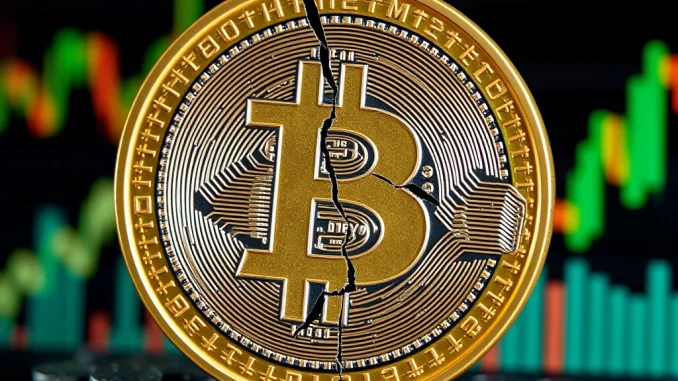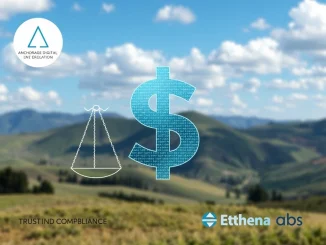
Urgent Alert for Crypto Holders! Are you tracking the FDUSD stablecoin? Recent market monitoring indicates a significant and concerning event: FDUSD has de-pegged from its dollar value, trading as low as $0.91 on CoinMarketCap, according to Coin Pulse Market Monitoring. This unexpected dip raises critical questions about stablecoin stability and the broader cryptocurrency market. Let’s dive into what this FDUSD de-pegging means for you and the crypto landscape.
Decoding the FDUSD De-pegging: What’s Happening?
A stablecoin like FDUSD is designed to maintain a 1:1 peg with a fiat currency, in this case, the US dollar. This peg is crucial for their role in providing stability within the volatile crypto market. When a stablecoin ‘de-pegs,’ it means it deviates from this intended value. In the case of FDUSD, trading at approximately $0.91 indicates a notable de-pegging event. This situation immediately sparks concerns about the mechanisms ensuring stablecoin stability and the potential ramifications for traders and investors holding FDUSD.
Here’s a breakdown of the key aspects to understand about this FDUSD de-pegging:
- The Immediate Impact: The most immediate effect is on holders of FDUSD. A price below $1 means that for every FDUSD they hold, its current market value is less than a dollar. This can lead to losses if users need to liquidate their holdings quickly.
- Market Sentiment: De-pegging events can erode trust in stablecoins, even temporarily. Traders may become hesitant to use FDUSD or other stablecoins perceived as risky, impacting trading pairs and liquidity across exchanges.
- Potential for Arbitrage: De-pegging situations often create arbitrage opportunities. Traders might attempt to buy FDUSD at lower prices on some exchanges and sell them on platforms where the price is closer to the peg, aiming to profit from the price difference.
- Wider Crypto Market Implications: While FDUSD is not the largest stablecoin, significant de-pegging events in any stablecoin can contribute to broader market uncertainty. It can trigger increased volatility and cautious trading behavior across the cryptocurrency ecosystem.
Why Does Stablecoin De-pegging Occur?
Stablecoins, despite their name, are not immune to fluctuations. Several factors can contribute to a stablecoin depeg, and understanding these is vital for navigating the crypto market:
- Market Volatility: Extreme market-wide volatility, especially in Bitcoin and Ethereum prices, can indirectly impact stablecoins. Panic selling or large-scale asset movements can strain stablecoin mechanisms.
- Redemption Issues: If users lose confidence and rush to redeem their FDUSD for actual US dollars, and if the reserves backing FDUSD are perceived as insufficient or illiquid, it can lead to price slippage below the peg.
- Smart Contract Vulnerabilities: While less common for established stablecoins, vulnerabilities in the smart contracts governing a stablecoin could be exploited, leading to instability.
- Regulatory Concerns: Uncertainty or negative news regarding stablecoin regulations can trigger fear and selling pressure, contributing to de-pegging.
- Whale Activity: Large holders of FDUSD (whales) making significant sell-offs can temporarily disrupt the market equilibrium and cause price deviations.
Navigating the FDUSD Price Drop: What Should You Do?
Witnessing a FDUSD price dip below $1 can be unsettling, especially for those holding this stablecoin. Here are some actionable insights:
- Stay Informed: Continuously monitor the FDUSD price on various reputable platforms like CoinMarketCap and CoinGecko. Track news and updates from official FDUSD sources and credible crypto news outlets.
- Assess Your Risk Tolerance: Consider your personal risk tolerance. Are you comfortable holding FDUSD during this period of volatility, or do you prefer to reduce your exposure?
- Evaluate Redemption Options: Understand the mechanisms for redeeming FDUSD for USD. Check for any limitations or potential delays in the redemption process during de-pegging events.
- Diversification: This event highlights the importance of diversification. Don’t hold all your stablecoin assets in a single coin. Spreading holdings across different reputable stablecoins can mitigate risk.
- Consider Market Conditions: Analyze the broader cryptocurrency market sentiment. Is this an isolated FDUSD event, or is it part of a wider market downturn affecting multiple assets?
The Broader Landscape of Crypto Stablecoin Concerns
The crypto stablecoin sector is under constant scrutiny, and events like the FDUSD de-pegging underscore the inherent risks, even in assets designed for stability. While stablecoins play a vital role in the crypto ecosystem, providing on-ramps, off-ramps, and trading pair stability, it’s crucial to remember they are not without risk.
Key Challenges for Stablecoins:
| Challenge | Description |
|---|---|
| Maintaining the Peg | Ensuring a consistent 1:1 peg to the fiat currency, especially during high volatility or redemption pressures. |
| Transparency and Reserves | Providing clear and auditable proof of reserves backing the stablecoin to build and maintain trust. |
| Regulatory Uncertainty | Navigating evolving and often unclear regulatory landscapes across different jurisdictions. |
| Centralization Risks | Concerns about the centralized nature of many stablecoins and the potential for single points of failure. |
Understanding Stablecoin Volatility: Is FDUSD Unique?
While the FDUSD de-pegging is noteworthy, it’s important to understand that stablecoin volatility, to varying degrees, is not uncommon in the crypto space. Even major stablecoins can experience slight deviations from their peg, although significant and prolonged de-pegging events are less frequent.
Factors Contributing to Stablecoin Volatility:
- Market Liquidity: Lower liquidity for a stablecoin can amplify price fluctuations when large trades occur.
- Trading Pairs: The depth and liquidity of trading pairs involving the stablecoin can influence its price stability.
- Underlying Asset Risk: For stablecoins backed by reserves, the risk profile of those reserve assets can indirectly impact the stablecoin’s perceived stability.
- Algorithm Complexity: Algorithmic stablecoins, in particular, have shown to be more prone to volatility and de-pegging risks due to their reliance on complex algorithms to maintain the peg.
Conclusion: Navigating the Unstable Seas of Crypto
The FDUSD de-pegging serves as a stark reminder of the dynamic and sometimes unpredictable nature of the cryptocurrency market. While stablecoins aim to offer a safe haven, events like these highlight the importance of vigilance, informed decision-making, and a balanced approach to crypto investing. By staying informed about market events, understanding the risks associated with stablecoins, and diversifying your portfolio, you can better navigate the volatile seas of the crypto world and make more resilient investment choices. Keep a close watch on FDUSD and the broader stablecoin market as this situation unfolds.



